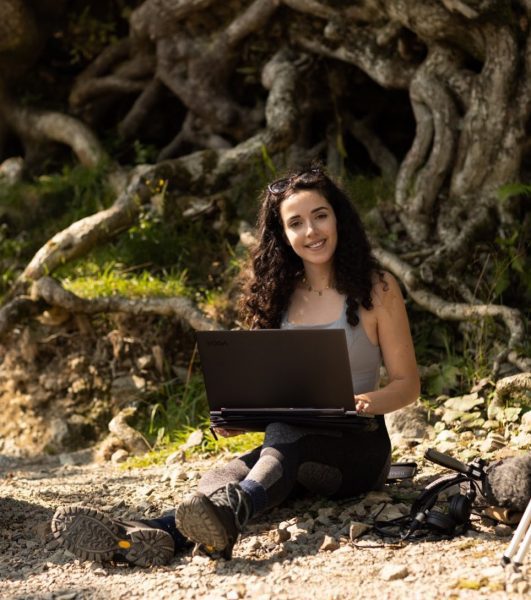Every year, environmentalists around the world use Earth Day as an opportunity to invite others to care more for our blue planet. This year, we find ourselves at a pivotal moment, confronted with two choices: take bold action as leaders or stand by and wait for our window of opportunity to close.
Each of us must take a step back and reflect on what we’re extracting from the Earth. As individuals, we have the power to make better, greener choices. However, we cannot do this alone. To truly combat this climate and ecological crisis, we need systemic change. Those in power and the systems they put in place must prioritize sustainability.
 But where do we start? Oftentimes, the biggest issue many of us face is the “how” behind Earth Day. “How can I make a difference? How is my contribution changing the Earth as a whole?” Regardless of where you are on your conservation journey, there’s always something you can do.
But where do we start? Oftentimes, the biggest issue many of us face is the “how” behind Earth Day. “How can I make a difference? How is my contribution changing the Earth as a whole?” Regardless of where you are on your conservation journey, there’s always something you can do.
Here are a few tangible ways to incorporate sustainability into your everyday lives, along with corporate initiatives businesses should consider implementing to keep our planet thriving.

- Adopt a plant-based diet
- Incorporating plant-based foods into our daily diets can have massive ecological impacts. Animal agriculture is the leading cause of ocean dead zones, habitat destruction and species extinction. In fact, one quarter pound hamburger requires over 660 gallons of water to produce – the equivalent of two-months’ worth of showering. Even if you’re a devoted omnivore, you can make a difference by simply opting out of meat for one or two meals a week.
- Minimize plastic pollution
- Every bit of plastic ever created still exists today, with humans producing 300 million tons each year. Ocean plastic is responsible for the death of over 100,000 marine mammals and turtles and 1 million seabirds annually. Recycling plastics and cutting out their usage altogether can dramatically improve Earth’s quality of life.
- Focus on quality over quantity
- Did you know fast fashion – an approach that emphasizes making fashion trends quickly and cheaply – is one of the biggest contributors to carbon emissions and water pollution? By 2050, it’s estimated that clothing production will account for 25% of the world’s carbon budget. In the UK alone, an estimated 350,000 tons of clothing are sent to landfills each year – the same weight as 70,000 African elephants (the heaviest land animal on the planet). So how can we counteract this? Support companies that maintain an ethical supply chain and avoid those that source raw materials through deep sea mining. Strive to buy clothing that’s made to last, fix garments if they break, and buy clothes second-hand. But, if you are buying new, aim to buy from ethical, carbon neutral brands.
- Promote a circular economy
- Since the traditional supply chain was built to end at the landfill, transitioning to a circular waste system will be extremely challenging. But we need to start somewhere. Companies must readjust their perspectives and create innovative programs that will positively impact global supply chains. For example, Lenovo’s trade-in program allows users to properly return and recycle select products and ensures hazardous e-waste doesn’t end up in landfills. Functioning products can be traded in for compensation, meaning you can earn money while helping the planet – it’s a win-win!
- Center renewable energy
- A swift and just transition to a renewable energy grid is our fastest pathway to net zero and meeting our global climate goals. We all play a role in supporting clean energy. Individuals can make the transition to an electric vehicle or explore solar panel options. And if those options aren’t accessible, advocating for renewable access through advocacy and support groups can also prove effective. Lenovo has announced a goal to source 90% of its electricity used in global operations from renewable sources within the next five years.
- Don’t forget about social sustainability
- Social sustainability is deeply intertwined with environmental sustainability. As we pave the way to a greener future, we must work to ensure it is accessible to everyone. To ensure our environmental efforts are inclusive, we must approach this work through an intersectional lens by asking ourselves, “Are all of our planet’s people being included and represented?” Lenovo has made bold commitments to ensure marginalized groups like women, underrepresented minorities, and those with physical limitations are provided opportunities to participate and lead in the workforce. On an individual level, we can use our voices to advocate for an inclusive and equitable work environment. Together, we can make sure everyone has a seat at the table.

As consumers, our decisions and dollars have the power to drive change and while there is communal joy in celebrating Earth Day, our planet is worth investing in 365 days a year. As mentioned above, for real change to occur, the systems in place and those who have the privilege and access to make greener choices, must prioritize sustainability.
This Earth Day and beyond, we challenge you to reflect and determine what changes you can make that will leave our Earth healthier and more prosperous for future generations.
To follow us on our #LenovoInnovators journeys and see first-hand how we live our lives sustainably every day, follow us on Instagram @roxythezoologist and @carissaandclimate or @theconservationistcollective.
